Home / All Recipes / Indonesian / Gulai Daun Singkong - Cassava (Yam) Leaves Curry
Gulai Daun Singkong - Cassava (Yam) Leaves Curry
On your next Asian market trip, get some yam/sweet potato/cassava leaves, and learn how to make this delicious and iconic Indonesian gulai daun singkong.

Padang cuisine is definitely one of my favorite Indonesian cuisines. And whenever I have the chance to visit a Padang restaurant, it is almost a certainty that I will grab some gulai daun singkong among the mountain of dishes to choose from.
I mean, have you ever walked into a Padang restaurant? The display of so many dishes, stacked like mountains, is the main draw, and the smell, of course.
It is always so difficult to decide which dishes to get, but this unassuming curry is so full of flavor, and to me, a proper nasi Padang is not complete without it.
What do I need to prepare gulai daun singkong Padang?
Like most Padang dishes, the ingredients list for this dish is quite long. You will need:
- daun singkong (yam/cassava/sweet potato leaves). These are sold as yam leaves in my nearby Asian market. For this specific dish, kale is the best substitute if you cannot find daun singkong in your grocery store.
- coconut milk
- ground coriander (Indonesian: bubuk ketumbar)
- ground turmeric (Indonesian: bubuk kunyit). You can use fresh turmeric too if you wish.
- shallots. I use smaller Asian/Chinese shallots, but feel free to use regular French shallots too. Just go by weight measurement to make sure you don’t use too many shallots. :)
- garlic
- red chilies. I use red Fresno chilies, but you can use red cayenne, or even red bird-eye chilies if you really love spicy dishes.
- ginger
- galangal
- candlenuts (Indonesian: kemiri). You can substitute this with the same amount of macadamia nuts.
- lemongrass
- daun salam (Indonesian bay leaves). These are not the same as regular bay leaves. If you can’t find these, it is best to omit.
- kaffir lime leaves (Indonesian: daun jeruk). Added at the very last minute to impart some fresh citrus note. This is optional and can be omitted.
- salt
- sugar
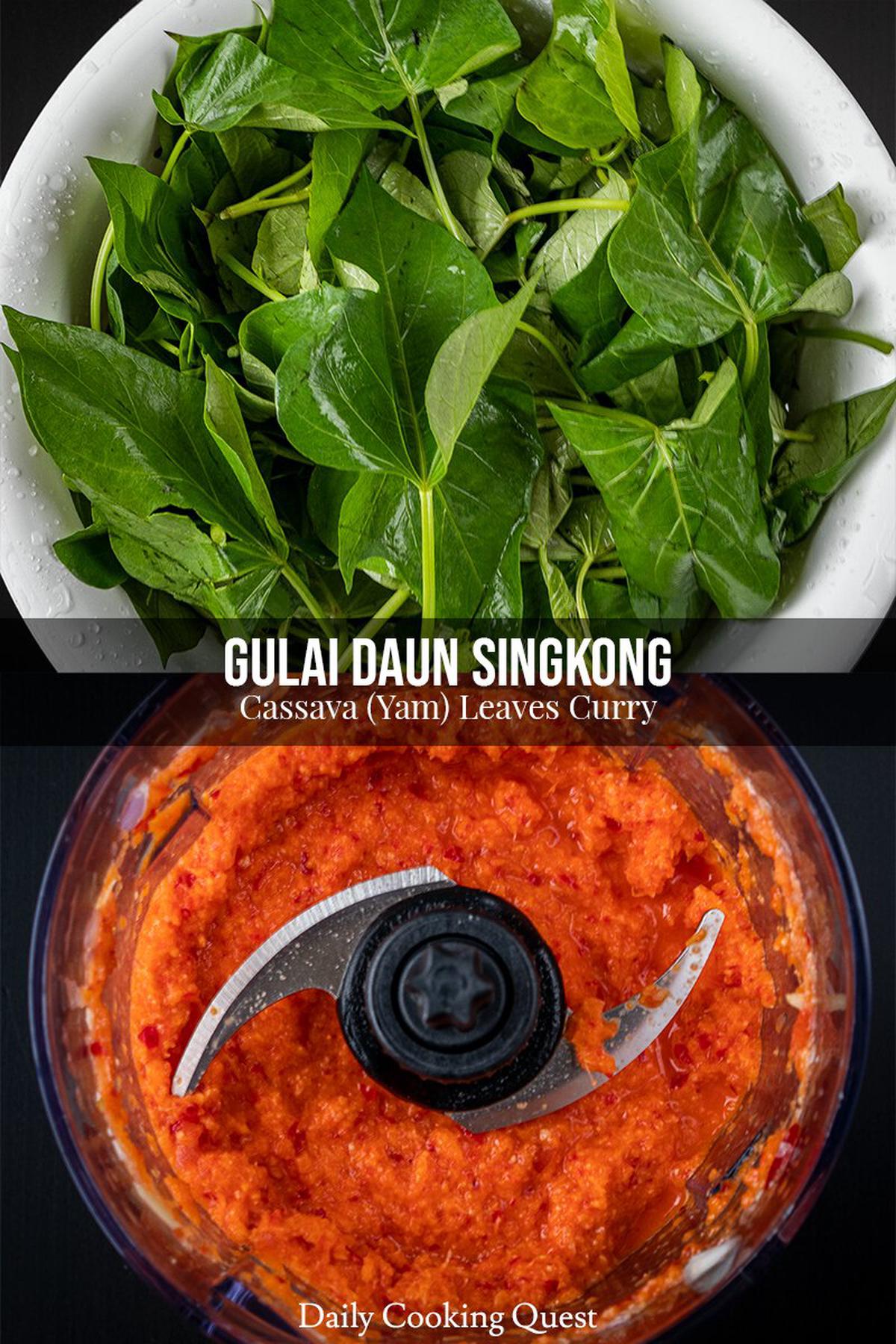
How do I prepare yam leaves?
From the market, yam leaves are sold attached to their stalks. Try to break the stalks, if they are fibrous looking, simply use the leaves. If the stalks are tender and not fibrous at all, feel free to include the stalks too in the dish. Regardless, please do the following to prep your yam leaves:
- Pinch off each leaf and its stem from the main stalk.
- If the main stalk has tender parts, usually more towards the top near where all the leaves are, pinch of those parts too. Probably 50% of the time, you will find that the main stalk will be too tough/fibrous to be used.
- Wash and rinse thoroughly under cold running water to remove dirt.
- Set aside to drain excess water before cooking.
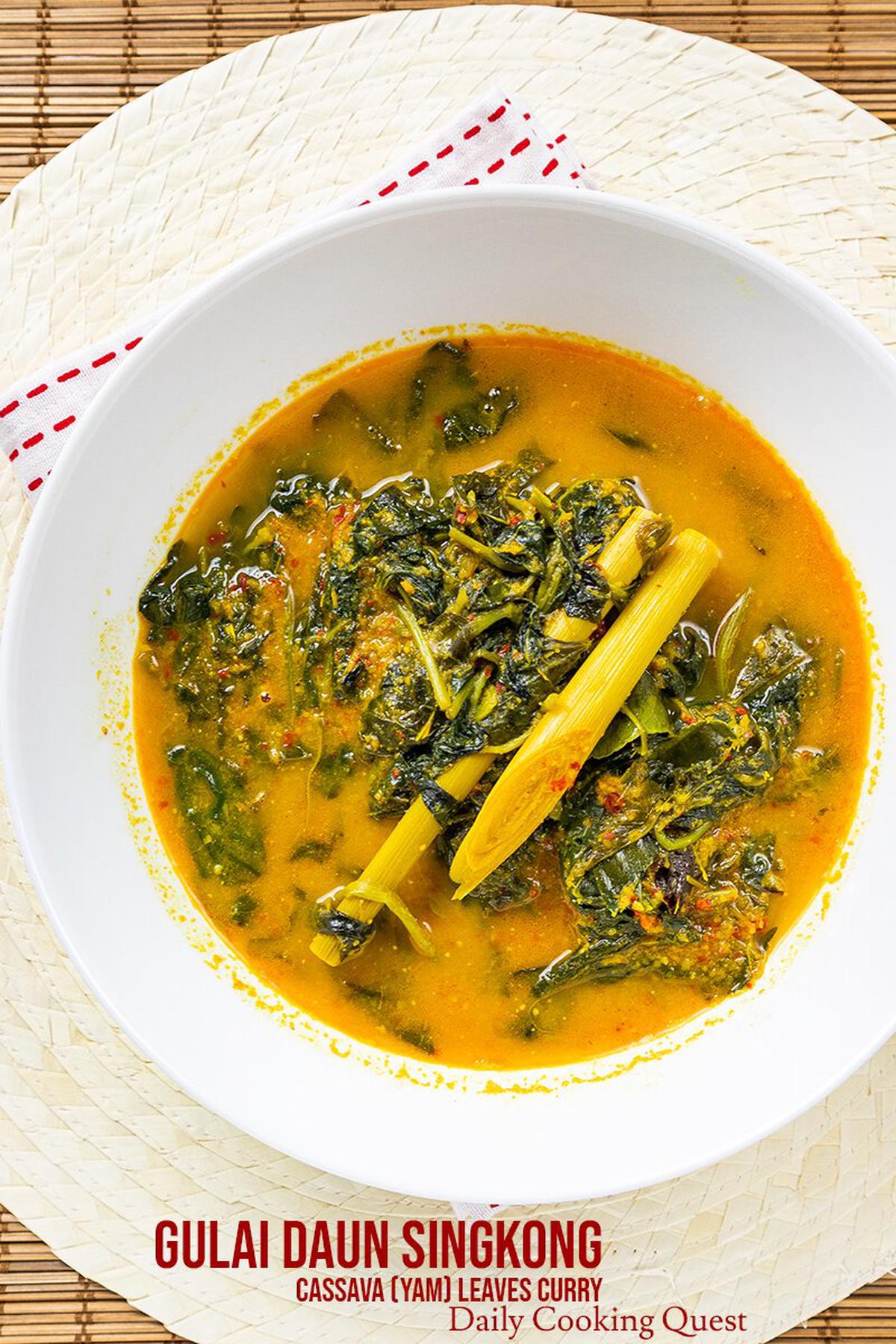
How do I cook gulai daun singkong?
Here is how I cook gulai daun singkong at home:
- Prep the daun singkong (yam leaves) as described in the previous section.
- Grind the spice paste. I use a food processor for this. You can use a blender, or even traditional mortar and pestle if that’s what you have.
- Heat cooking oil in a wok/pot/deep skillet (I use a wok), and fry the spice paste until fragrant, about 3-5 minutes.
- Add daun salam (if using) and lemongrass, cook for another 2 minutes.
- Add yam leaves and water into the wok, and bring to a boil. Reduce the heat to a simmer and cook for 15 minutes.
- Add coconut milk, salt, and sugar. Continue simmering for 5 minutes.
- Add kaffir lime leaves (if using), and stir for 1 minute. Turn off heat, and serve immediately with steamed white rice.
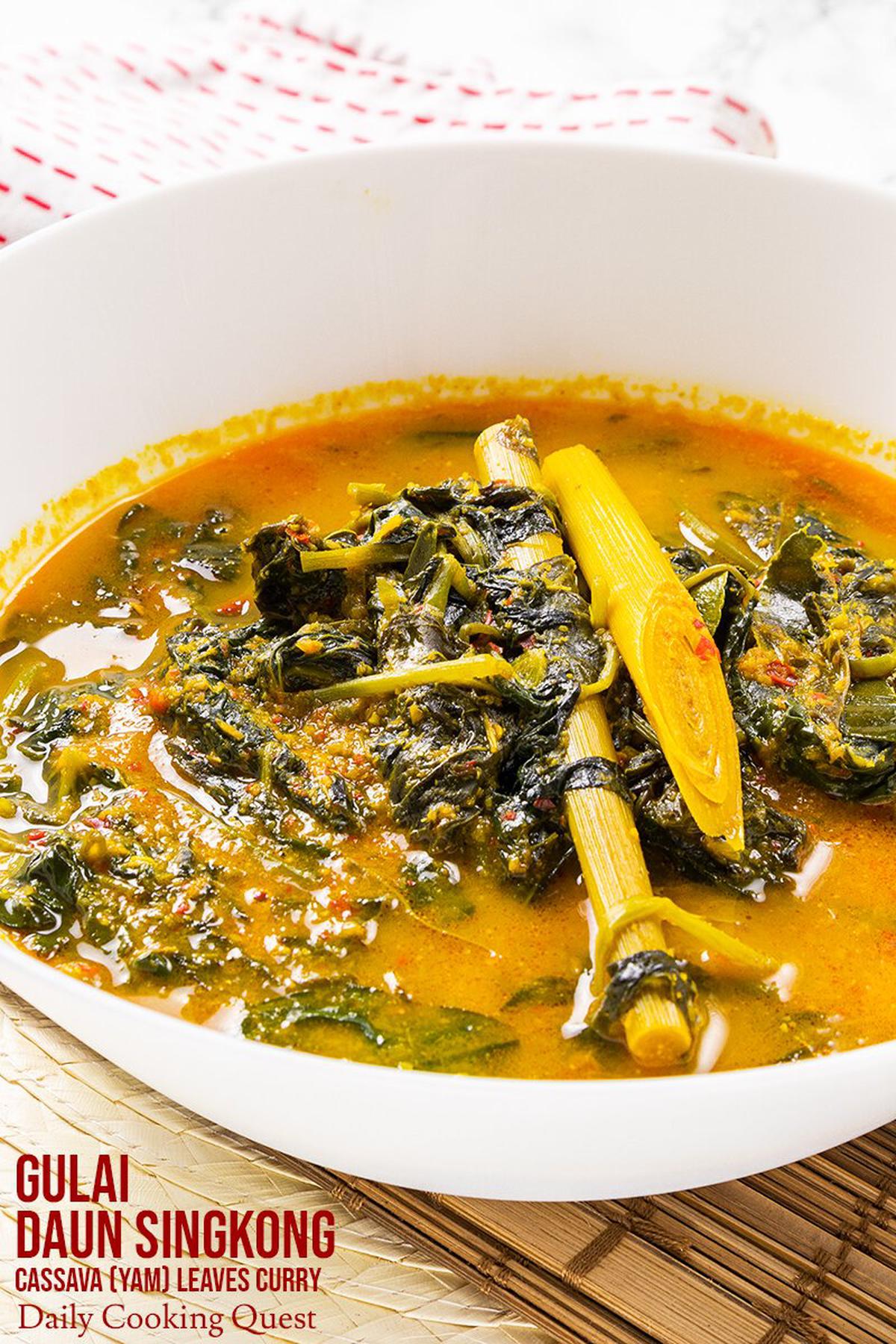
Other Padang dishes recipes to try
If you love this gulai daun singkong and would love to try cooking other Padang restaurant dishes at home. Please give these recipes a try:
Gulai Daun Singkong - Cassava (Yam) Leaves Curry
Ingredients
- 500 gram (1.1 lb.) yam/cassava/sweet potato leaves (Indonesian: daun singkong)
- 2 tablespoon cooking oil
- 5 bay leaves (Indonesian: daun salam), omit if you don't have these
- 1 lemongrass (Indonesian: sereh), chopped into 4 pieces
- 750 ml (3 cup) water
- 250 ml (1 cup) coconut milk
- 1/2 tablespoon salt
- 1 teaspoon sugar
- 5 kaffir lime leaves (Indonesian: daun jeruk), omit if you don't have these
- Spice paste (grind together the following ingredients)
- 5 red chilies (Indonesian: cabe merah), I use Fresno, but feel free to use red cayenne, or even red bird-eye chilies if you wish
- 8 (120 gram / 4 oz.) shallots (Indonesian: bawang merah)
- 2 cloves garlic (Indonesian: bawang putih)
- 3 candlenuts (Indonesian: kemiri), or macadamia nuts
- 1 inch fresh ginger (Indonesian: jahe)
- 1 inch fresh galangal (Indonesian: lengkuas)
- 1/2 tablespoon ground coriander (Indonesian: bubuk ketumbar)
- 1 teaspoon turmeric powder (Indonesian: bubuk kunyit)
Instructions
- Pinch off each leaf and its stem from the main stalk. Pinch off also the portion of the main stalks that are tender. Wash and rinse thoroughly a couple of times and set aside to drain off any excess water before cooking.
- Heat cooking oil in a wok/deep skillet/pot and fry the spice paste until fragrant, about 3-5 minutes.
- Add daun salam/Indonesian bay leaves (if using) and lemongrass and cook for another 2 minutes.
- Toss in the cassava leaves and pour water into the skillet. Cook until boiling. Reduce heat and simmer for 15 minutes.
- Add coconut milk, mix well, and simmer for another 5 minutes. Adjust salt and sugar as needed.
- Add kaffir lime leaves (if using), and stir for 1 minute. Turn off heat, and serve immediately with steamed white rice.
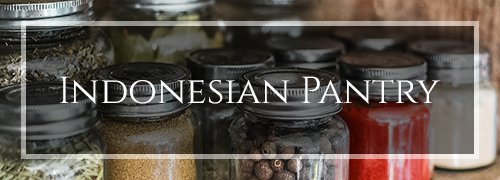

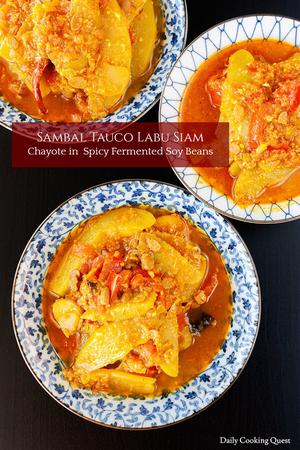

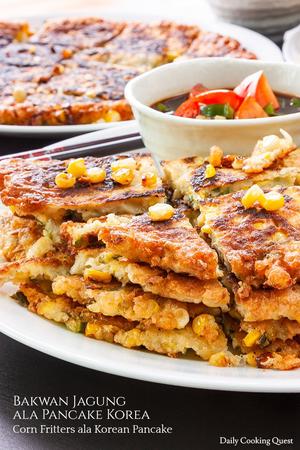
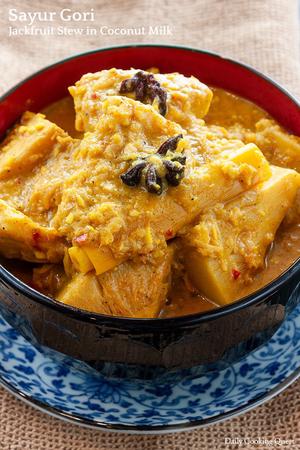
Comments
Hi Anita, First: I really love your website! It is the best source for Indonesian cooking I've found on the internet, and the photos are all very beautiful! I had a question about this recipe in particular. If candlenuts are not available, what is a good substitute? Thanks for such a lovely site!
Hi Mark, thank you for your kind words :) The best substitute for candlenut is macadamia nut, which is much easier to find outside of Indonesia.
Hi Anita, ini resep pertama yng saya masak. Rasanya enak sekali.
Wah, thank you Yudhi :)
Tapi saya tidak bisa mendapatkan daun singkong disini. Jadi saya ganti pakai KALE dan pakai ikan teri nasi. Saya senang dan suka dng resep-resep yng anda posting. Karena saya besar di Jakarta. Thanks for great and delicious recipe.
Probably need to pre treat the leaves by boiling in salted water. Can try adding anchovies and petai.
Good idea Peter :)
Good recipe , thank you for sharing
that's what I usually do, boil the cassava leaves first.instead of anchovies, i prefer to use any dried salted fish or ebi
Hi Anita, Just found your website and love the recipes I've tried so far. I used to live Sumatra and missed eating all these wonderful dishes! Several questions about purchasing: How do find thin coconut milk? I know some people just water down the canned coconut milk but it seems like everyone has a different ratio. Where have you been able to find Cassava leaf? I look at several major Asian grocery stores in the DC area and no one had it When you use shallots are they just the normal 2inch shallots sold in every grocery store? I guess i never realized how many shallots it takes to make an indonesian feast!
Hi Ben, glad you love my recipes and they remind you of the good food you had in Sumatra :) If a recipe says thick coconut milk, I usually use canned coconut cream (e.g. this one), and when it just says coconut milk, any regular canned coconut milk will do. If you think the regular canned coconut milk is too thick, you can definitely try water it down. Yeah, ratio can be hard to pin down since most of Indonesian recipes that has them, we can always control the amount of sauce by simply cooking it for a shorter/longer period of time. :D But, if you must water it down, try with 1 part coconut milk to 1/2 part water first. I think it is safer not to water it down too much since we can add more water if need be, but the reverse might not be that easy, especially if no more coconut milk supply is at hand! Cassava leaf is really hard to find here. In fact, when I wrote this recipe I was still back in Jakarta. I have tried to replicate this recipe using kale with great success though, and kale is super easy to find :) Just use the exact same amount of leaf. You are absolutely right that Indonesian shallot is smaller in size compared to the ones sold here in US. When I don't give out specific weight, you can safely assume 1 regular US shallot = 3 Indonesian sized smaller shallots. Hope this helps :)
Thank you so much! I should have checked back sooner, but for some reason it didn't send an email when you replied! One more question, when you're measuring out the ginger, galangal, and turmeric. the pieces at my local asian market vary wildly in thickness. Is it pretty much just equal portions of all three? And then following up on your coconut milk answer, so i should just use the cream for this recipe and then regular canned coconut milk for things like the jackfruit curry recipe that call for "thin coconut milk (Indonesian: santan)"?
Hi Ben, turmeric is generally much thinner compare to ginger or galangal, so I would use the same amount of ginger and galangal, but only half for turmeric (assuming you are going by weight). For this particular recipe, if you are using regular canned coconut milk, start with 1 can milk + 1 can water should be pretty safe.
Hi Anita! I just made this with Kale because I live in London and can’t find daun singkong. It turned out to be so good! I’ve been “ngidam” for gulai daun singkong for quite some time and I’m so happy to finally able to find this recipe on your page. My hubby super loved it too. Thank you for sharing your recipes :)
I'm glad your gulai turns out great with kale. I am blessed that I can still find cassava leaves in my Asian supermarket, though not all the time. I, too, substitute with kale whenever I can't find cassava leaves. :)
I loved this recipe, thank you!
This sounds delicious. I am going to try to find some yam or sweet potatoes leaves this weekend so I can make it. I think my Asian supermarket might have some, if not I will use Kale.
I have never tried Indonesian cuisine or heard of cassava leaves. I like all the info you give and this recipe sounds delicious! I'm eager to give it a try. Thanks for sharing.
I made this and loved it. 2020 is the year our family will be broadening our palates.
Wow this sounds amazing. I haven't tried too much Indonesian dishes and this is a dish I would love to give a go. Thanks for the great recipe!!
I love trying something new! It look me a while to find these leaves, but it was worth the wait - what a delicious and comforting stew!
Hello Anita and thank you so much for this wonderful recipe! Honestly, I’ve never taken the time to review anything, but this deserved an extra minute of my time. My family (even my pickiest eater) loved this recipe! All the flavors blended together to make this delicious! Pinning!
Hi Anita, I made mine with kale because daun singkong is difficult to find here. It was good and you can add ikan teri as well to make them tastier.
Yam (=sweet potato) and Cassava are two different things (Ubi and Singkong). The leaves looks also totally different. Commonly cooked in Padang cuisine is actually daun Singkong which are cassava leaves.
Hi James, you are right. For those who want to prepare this dish using fresh ingredients, the best is to get yam leaves from an Asian grocery store. If you are okay with using frozen ingredients, you can head to the freezer aisle and try looking for a packet of cassava leaves. Cassava leaves are usually sold in pounded/crushed form and not intact, so there's that consideration too.
I found that collard greens work very well too! Thank you so much for sharing this recipe.
yum! Padang food is my favorite ever. I lived in Bandung for a couple of years and fell in love with this food. Gimme a bungkusan of rendang, daun singkong, telur balado, sayur nangka, sambal hijau, nasi putih, plus another ladle of kuah over the top, and I'm in heaven! Now I live on a Pacific island that has cassava, but nobody eats it or uses spices on any of their food, so my tastebuds are pretty dead. My goal before I hit 40 is to cook all my Padang favorites and chow! lovely recipe and pics, thanks.
oops, forgot to add a question: usually when I eat daun singkong at a Rumah Makan Padang, the singkong is just boiled in water. It's a nice change from all the heavy coconut milk and spices of the other dishes, almost like a palate cleanser. Your recipe, which looks amazing, and I will definitely be trying, is much richer. Do they usually serve singkong this way in Sumatra? (I've never been there). Just curious. Your recipe looks like it's so rich and tasty that I could eat it with white rice and be happy, no need to slave over the other dishes-hah!
Hi Heidi, there are usually two versions, gulai daun singkong (curry version) and daun singkong rebus (plain boiled version).
To cook daun singkong rebus, boil a pot of water with 1 tablespoon of salt, add just the leaves (discard all the stalks) and boil until they wilt and turn soft and tender. Younger cassava leaves need about 5 minutes of cooking time. The older more mature leaves may need up to 10 minutes of cooking time. Once they are soft, strain and squeeze to remove as much water as possible, and serve with your favorite sambal.
First time I had daun singkong was in 1979, with a Minang family in a little village in West Sumatera, about 20 km from Bukit Tinggi. It was life changing, because at the same meal I also had rendang for the first time, and my understanding of food and flavour changed that instant and has never been the same since. And I've been making rendang ever since, but it's impossible to find daun singkong where I live, so each time I go back to Indonesia I eat it as much as possible. This recipe is spot on, my Ibu would have been proud.
I believe the picture of the leaves are sweet potato leaves. It's a little misleading to refer to the dish as daun singkong/cassava leaves.
Hi Anita, thank you for this recipe ❤️
You are SO right. No nasi Padang is complete without this! I live in London. Have you ever found Indonesian bay leaves in the UK? How do you tell them apart?
Hi Nuala, in the US, bigger Asian grocery stores usually sell dried Indonesian bay leaves. When I don't have the time to go to physical stores, I can even order online from Amazon. I am not sure where you can buy them in London though, I am sorry.
Indonesian bay leaves are much bigger in size compared to your regular bay leaves, so there is that. Also, the dried Indonesian bay leaves are all imported from Indonesia.
Leave a comment